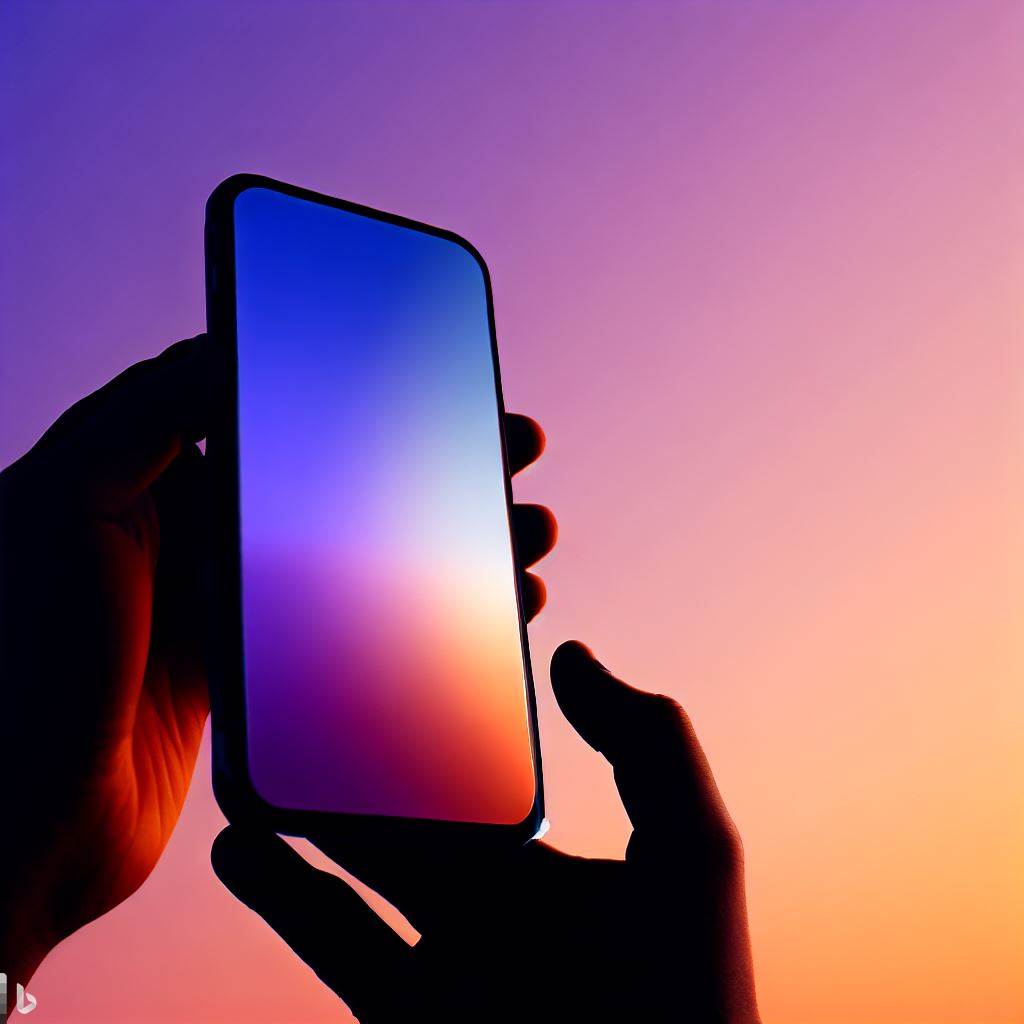To help you capture stunning photos with your mobile device, here are some tips and tricks:
- Clean your lens: Before taking a shot, ensure your phone’s camera lens is clean. Fingerprints and smudges can negatively affect image quality.
- Master your camera settings: Familiarize yourself with your phone’s camera app and its settings. Explore features like exposure control, manual focus, gridlines, HDR, and more.
- Use natural light: Natural light is generally the most flattering for photography. Try to shoot during the golden hours (shortly after sunrise and before sunset) for warm, soft light.
- Rule of thirds: Compose your shots using the rule of thirds. Imagine your frame divided into nine equal parts with two horizontal and two vertical lines, and place your subject along these lines or their intersections.
- Steady your phone: Minimize camera shake by holding your phone with both hands or use a tripod. Some phones have a built-in stabilizer or enable gridlines to help you level the shot.
- Don’t use digital zoom: Digital zoom decreases image quality. Instead, get closer to your subject or consider cropping the photo later.
- Experiment with angles and perspectives: Try shooting from various angles—low, high, or at eye level—to add depth and interest to your photos.
- Focus and exposure: Most camera apps allow you to tap on the screen to set the focus and exposure point manually. Use this feature to control what’s in focus and adjust exposure levels.
- Use HDR mode wisely: HDR (High Dynamic Range) can be great for capturing details in high-contrast scenes, but it may not always be necessary. In some situations, it can make photos look artificial.
- Avoid using flash: Smartphone flashes are generally harsh and can wash out your subject. Whenever possible, use natural or ambient light.
- Edit your photos: After taking your shot, use photo editing apps to enhance the final result. Adjust brightness, contrast, saturation, and sharpness to make your images pop.
- Use burst mode for action shots: When photographing fast-moving subjects, use burst mode to capture a series of photos in quick succession. This increases the chances of getting a perfect shot.
- Explore third-party camera apps: Many third-party camera apps offer advanced features not found in the default camera app. Experiment with different apps to find the one that suits your style.
- Keep your camera app accessible: Enable quick access to your camera from the lock screen or home screen, so you don’t miss spontaneous photo opportunities.
- Pay attention to composition: Besides the rule of thirds, look for leading lines, patterns, symmetry, and interesting backgrounds to make your photos visually appealing.
- Use the grid: Enable the gridlines on your camera app to help you align your shots and create balanced compositions.
- Shoot in RAW format: If your phone supports it, shoot in RAW format. RAW files preserve more image data, allowing for better post-processing without loss of quality.
- Portrait mode: Experiment with the portrait mode or depth-of-field effect to create professional-looking images with a blurred background.
- Add lens accessories: Consider using external lenses like macro, wide-angle, or telephoto to extend your phone’s photography capabilities.
- Practice, practice, practice: The more you practice, the better you’ll become at mobile photography. So, keep snapping and experimenting with different techniques.
- Use the native camera app: While third-party camera apps can be great, the native camera app often receives the best optimization and updates for your specific phone model.
- Avoid digital filters: Instead of applying built-in filters, consider using photo editing apps to have more control over the editing process. Presets and filters can quickly make a photo look generic.
- Shoot in landscape orientation: Landscape orientation is often more visually appealing, especially for wide-scene shots. Reserve portrait mode for specific subjects that benefit from it, like portraits of people or tall buildings.
- Explore the manual mode: If your phone’s camera app has a manual mode, experiment with adjusting settings like ISO, shutter speed, and white balance to gain greater control over your photos.
- Capture candid moments: Candid shots can result in some of the most authentic and emotional photos. Be discreet and patient to catch genuine moments.
- Understand exposure: Learn to balance exposure by adjusting settings or tapping on different areas of the screen to set the exposure point correctly.
- Utilize negative space: Negative space, the area around the subject, can add emphasis and make your subject stand out.
- Pay attention to the background: A cluttered or distracting background can take away from your subject. Keep it simple and unobtrusive whenever possible.
- Shoot in burst mode for group photos: When taking group photos, use burst mode to ensure you capture a shot with everyone’s eyes open and smiling.
- Use the “AE/AF Lock” feature: Most camera apps allow you to lock the focus and exposure on a specific subject. Use this to maintain consistent settings when you reframe the shot.
- Experiment with long exposure: Some camera apps or third-party apps offer long exposure capabilities. Use this to create stunning light trails or smooth water effects.
- Include reflections: Look for reflective surfaces like water, glass, or polished floors to capture interesting reflections of your subject.
- Shoot in black and white: Try using the monochrome mode or converting your color photos to black and white for a classic and artistic look.
- Practice portrait composition: Pay attention to the positioning of your subject’s eyes and give them space to look into the frame. Avoid cutting off body parts at joints.
- Learn about the exposure triangle: Understand how aperture, shutter speed, and ISO work together to control the exposure of your photos.
- Use leading lines: Leading lines, like roads, railings, or fences, can guide the viewer’s eyes towards the main subject.
- Capture textures: Get up close to capture interesting textures like tree bark, fabric, or architectural details.
- Look for symmetry and patterns: Symmetry and patterns can create visually stunning and satisfying images.
- Shoot from different distances: Experiment with various distances from your subject to find the most flattering and engaging angle.
- Tell a story: Try to capture a series of photos that tell a story or document a particular event or moment in time.
- Use the HDR mode for high-contrast scenes: HDR (High Dynamic Range) mode can be particularly helpful in situations where there are extreme differences between the bright and dark areas in your photo. It helps retain details in both the highlights and shadows.
- Keep the camera steady in low light: In low-light situations, camera shake becomes more apparent and can result in blurry photos. Steady your phone by bracing it against a stable surface or use a tripod if possible.
- Shoot during the blue hour: The blue hour occurs before sunrise and after sunset when the sky has a deep blue hue. This period can provide unique and captivating lighting conditions for your photos.
- Experiment with panning: Panning involves tracking a moving subject with your camera while using a slower shutter speed. This technique can create a sense of motion and blur the background, making the subject stand out.
- Play with reflections and water: Look for reflections in water bodies, puddles, or even glass surfaces. Experiment with different angles to create captivating compositions.
- Create a silhouette: To capture a stunning silhouette, expose for the brighter background, and position your subject as a dark outline against it.
- Capture symmetry in architecture: Architectural elements often provide symmetrical patterns and lines. Look for buildings, bridges, and other structures to create captivating geometric compositions.
- Use the exposure compensation slider: Many camera apps offer an exposure compensation slider. Adjust it to brighten or darken your photo without changing other settings.
- Capture motion with burst mode: Burst mode is not only useful for action shots but also for capturing moving subjects like flowing water or falling leaves.
- Get creative with lens flares: Direct sunlight hitting the camera lens can create lens flares. Use them creatively to add a dreamy or artistic touch to your photos.
- Utilize the self-timer: If you want to be part of the shot or avoid camera shake when taking a photo, use the self-timer function.
- Use apps for long exposure effects: If your phone’s native camera app doesn’t support long exposure, try using third-party apps that allow you to simulate this effect.
- Capture candid expressions: Candid expressions often convey genuine emotions. Be ready to snap photos when people are relaxed and engaged in their activities.
- Shoot from unconventional angles: Don’t be afraid to get down low or shoot from high above to give your photos a fresh and unique perspective.
- Utilize symmetry with reflections: When shooting reflective surfaces, look for symmetrical scenes that become even more impactful with the reflection.
- Capture urban scenes at night: City lights and architecture can create mesmerizing night scenes. Experiment with longer exposures and find creative ways to incorporate artificial lighting.
- Use the panorama mode: Capture breathtaking landscapes by using the panorama mode to stitch multiple shots together.
- Capture smoke or steam: Smoke or steam can create interesting visual effects. Try capturing smoke from candles, cigarettes, or steam from a hot beverage.
- Create intentional lens flare: While lens flares can sometimes be unwanted, you can intentionally create them by angling your phone towards a light source.
- Combine multiple apps for editing: Don’t limit yourself to just one editing app. Combine the strengths of different apps to achieve the desired look for your photos.
- Utilize the AE/AF lock for creative exposure: When using the Auto Exposure (AE) and Auto Focus (AF) lock, you can achieve creative exposure effects by focusing on a different area than the subject or locking exposure for a specific part of the scene.
- Shoot in RAW + JPEG: If your phone supports it, shoot in both RAW and JPEG formats. RAW files retain more data and allow for better post-processing adjustments.
- Capture silhouettes during sunrise and sunset: Take advantage of the dramatic colors during sunrise and sunset to capture stunning silhouettes of subjects against the vibrant sky.
- Photograph water droplets: Capture close-up shots of water droplets on surfaces or plants to add a sense of freshness and detail to your photos.
- Use the “Bokah” effect: Some camera apps offer a “Bokah” or background blur effect. Use this to create a beautiful separation between your subject and the background.
- Experiment with double exposures: Some editing apps enable you to create double exposures by overlaying two images. This technique can produce unique and artistic results.
- Capture emotions in street photography: Street photography is all about capturing emotions and candid moments of people in public places. Be discreet and respectful while taking photos of strangers.
- Focus on the details: Zoom in and capture intricate details of everyday objects to reveal hidden beauty.
- Use the “Portrait” mode for non-people subjects: The Portrait mode on many phones can be used to add depth and background blur to non-human subjects, such as pets or flowers.
- Create light painting effects: In low-light conditions, use a slow shutter speed or long exposure app to create light painting effects with flashlights or other light sources.
- Experiment with black and white landscapes: Black and white can add a timeless and artistic feel to landscape photos. Look for scenes with strong contrast and texture.
- Shoot through objects: Frame your subject by shooting through objects like leaves, windows, or fences to add an interesting foreground element.
- Capture candid pet moments: Photographing pets can be challenging but rewarding. Use treats or toys to get their attention and capture their playful and curious expressions.
- Photograph reflections in puddles: After rainfall, look for puddles to capture reflections of the surrounding environment.
- Take advantage of golden reflections: During the golden hour, position your subject near reflective surfaces like water to capture warm and magical reflections.
- Use symmetry with architecture: Look for symmetrical buildings or structures to create striking architectural shots.
- Explore the macro mode: If your phone has a macro mode, use it to capture intricate details and textures of small subjects up close.
- Photograph local events and festivals: Capture the vibrant atmosphere and cultural celebrations of local events and festivals in your area.
- Shoot in burst mode for pet photography: Pets can be quite unpredictable, so use burst mode to capture a series of shots and increase your chances of getting the perfect shot.
- Create a photo series: Tell a story or explore a theme by creating a series of photos with a cohesive visual style.
- Use the “Live Photo” feature: If your phone supports it, try using the “Live Photo” feature, which captures a short video clip before and after taking a photo. You can select the best frame or even turn the Live Photo into a loop or a long exposure effect.
- Explore monochromatic themes: Create a series of photos with a specific color theme, such as capturing only red objects, to add a cohesive and artistic element to your gallery.
- Photograph architecture at night: Cities often come alive with lights at night. Experiment with long exposures to capture the dynamic cityscape.
- Capture the golden ratio: The golden ratio is a compositional rule that can create visually pleasing and harmonious images. Compose your shots using this principle to add a sense of balance.
- Create abstracts from everyday objects: Look for abstract patterns and textures in ordinary objects like fabrics, surfaces, or even food.
- Photograph seasonal changes: Document the beauty of nature by capturing the same location during different seasons, showcasing the transformation over time.
- Use negative space creatively: Embrace negative space in your compositions to create a sense of minimalism and draw attention to your subject.
- Focus on leading lines in landscapes: Leading lines can guide the viewer’s eyes through the image and create a sense of depth in landscapes.
- Experiment with long shadows: Capture photos during the early morning or late afternoon when long shadows are cast, adding drama and dimension to your scenes.
- Photograph reflections in urban environments: Look for reflective surfaces in cities, like windows or polished metal, to capture intriguing reflections of the cityscape.
- Shoot in burst mode for wildlife: When photographing wildlife or moving animals, use burst mode to increase your chances of getting a sharp shot.
- Use the Rule of Odds: When photographing multiple subjects, try to include an odd number of objects (3, 5, 7, etc.) to create a more visually interesting composition.
- Capture the beauty of fog and mist: Misty or foggy weather can add a sense of mystery and ethereal beauty to your photos.
- Photograph textures in nature: Explore nature to capture various textures, like tree bark, moss, or rock formations, for visually engaging photos.
- Shoot candid street portraits: Capture authentic and candid street portraits of people going about their daily lives. Be respectful and ask for permission when necessary.
- Use symmetry in reflections: Find scenes with symmetrical elements that are reflected in water to create eye-catching compositions.
- Experiment with slow shutter speeds for motion blur: Create a sense of movement by using slow shutter speeds to intentionally blur subjects like waterfalls or moving traffic.
- Photograph food creatively: When photographing food, play with different angles, natural light, and props to make your dishes look appetizing and visually appealing.
- Capture local culture and traditions: Travel locally or abroad to document unique cultural practices, festivals, or traditional ceremonies.
- Have a photography challenge: Set yourself a weekly or monthly photography challenge to keep your creativity flowing. It could be focused on a specific theme, technique, or subject.




